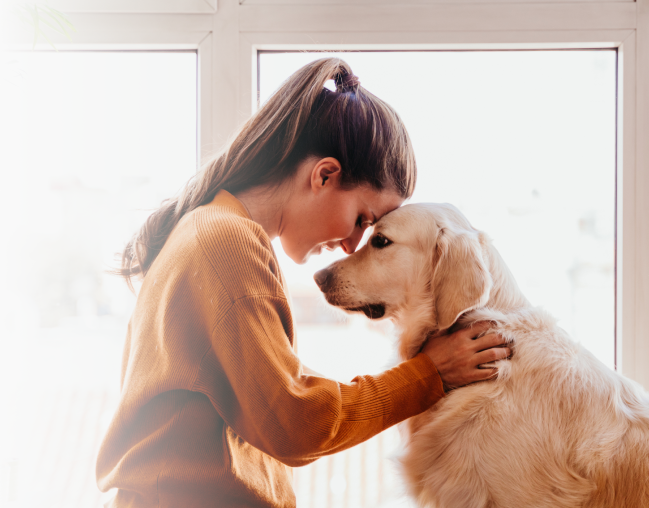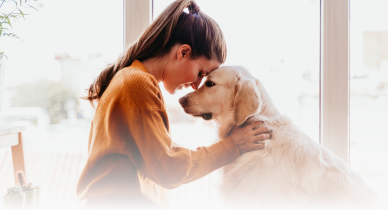The Australian Shepherd, often mistaken for for the Australian Cattle Dog, actually hails from the United States. This dynamic breed is renowned for its unmatched work ethic, intelligence, and striking appearance. With a blend of beauty and brains, Australian Shepherds captivate hearts and minds as versatile companions.
Did You Know these Facts about the Australian Shepherd?
-
Despite the name, Australian Shepherds have no connection to Australia. They were developed in the USA as ranch dogs and were associated with Basque shepherds who came from Australia – hence the name.
-
Australian Shepherds thrive on tasks and mental challenges. They shine in dog sports like agility, herding, and obedience, where their intellect and athleticism take center stage.
-
These dogs flaunt a range of coat colors and patterns, from the classic merle to solid shades. Their distinct coat patterns often make them stand out in a crowd.
-
Beyond herding, Australian Shepherds excel in search and rescue, therapy work, and even as guide dogs. Their innate versatility makes them ideal companions for active households.
-
Some Australian Shepherds are born with naturally short tails or no tails at all, a trait known as "bobtail." This unique characteristic adds to their individuality.
The Australian Shepherd holds a prominent number 12 spot in the American Kennel Club´s list of most popular breeds.. Its intelligence, loyalty, and adaptability have led it to be a beloved choice for families, active individuals, and those seeking a canine partner for various activities. Currently, it ranks among the top breeds, consistently captivating the hearts of dog lovers globally.

Traits of the Australian Shepherd Dog Breed
Personality. Australian Shepherds are an embodiment of boundless energy and remarkable intelligence. Their minds are as agile as their bodies, and they require mental and physical stimulation to thrive. These dogs are not for the faint of heart; they are a perfect match for owners who can match their active lifestyles. Their insatiable curiosity and quick-witted nature make them eager learners, always up for a challenge or a new trick. Whether it's learning complex commands, participating in dog sports, or embarking on outdoor adventures, Australian Shepherds shine when engaged in activities that stimulate their minds and bodies.
Family Life. When it comes to their families, Australian Shepherds form bonds that run deep. Their loyalty knows no bounds, and they're renowned for their unwavering devotion to their human pack. This affectionate nature extends to children, making them wonderful playmates and protectors.
However, it's essential to note their herding instincts that might lead them to try and corral children or other pets. To ensure harmonious interactions, early training and socialization are key. With the right guidance, these instinctive behaviors can be harnessed into positive interactions, allowing Australian Shepherds to thrive in family settings.
Appearance. Underneath their medium-sized frames lies a powerhouse of muscles and agility. Australian Shepherds were bred to be working dogs, and their physical build reflects this heritage. Their strong bodies enable them to excel in various tasks, from herding livestock to participating in dog sports that demand speed, endurance, and flexibility. Their coats showcase a spectrum of colors and patterns, including the iconic merle, black, and red. This diversity adds to their individuality, making each Australian Shepherd a unique work of canine art.
Sociability. While Australian Shepherds might appear reserved when encountering strangers, they possess a friendly disposition waiting to be uncovered. Proper socialization from an early age is vital to help them develop into well-rounded and welcoming companions. With the right exposure to different people, animals, and environments, Australian Shepherds can blossom into dogs that extend their warm hospitality to both familiar faces and newcomers.
Average Sizes & Life Expectancy
- Height: 18 to 23 inches tall (46 to 58.5 cm)
- Weight: 40 to 65 pounds (18 to 29.5 kg)
- Life Expectancy: Around 12 to 15 years
Detailed Description of the Australian Shepherd Dog Breed
The Australian Shepherd, often affectionately known as the "Aussie," is a captivating breed celebrated for its remarkable intelligence, striking appearance, and unparalleled work ethic. Hailing from the Basque region of the Pyrenees, the breed's history is interwoven with the story of sheepdogs that were brought to America in the 1800s.
Over decades, these versatile canines carved a niche for themselves, displaying exceptional herding abilities and adapting to a multitude of roles. Today, the Australian Shepherd continues to captivate hearts with its boundless energy, unwavering loyalty, and enduring versatility.
Appearance. The Australian Shepherd boasts a medium-sized, robust frame that belies its incredible agility and strength. Standing at an average height of 18 to 23 inches and weighing 40 to 65 pounds, their proportions are optimized for the demands of their working heritage.
Their eyes, captivatingly expressive and often paired with the iconic merle coat pattern, come in shades that mirror the hues of the sky. The breed's triangular ears stand alert, capturing every sound that resonates in their surroundings.
Temperament. Australians Shepherds are blessed with minds that rival their bodies in agility. Their intelligence is legendary, and they thrive when their mental faculties are engaged in activities that challenge and stimulate. Highly trainable and eager to learn, Aussies are adept at mastering complex commands and tricks. Their versatile nature makes them excel in various roles, from herding livestock on the ranch to competing in dog sports like agility, obedience, and even canine freestyle.
Adaptability. While their background as working dogs suggests a preference for an active lifestyle, Australian Shepherds can adapt to various living conditions. However, they thrive in environments that allow them to expend their abundant energy and engage their minds. Homes with yards, ample exercise opportunities, and mental stimulation are ideally suited for these dynamic canines.
Families, couples, and individuals alike can find a loyal and loving companion in the Australian Shepherd, provided they are ready to meet the breed's needs for physical and mental activity.
Care Guidelines. Caring for an Australian Shepherd involves more than just meeting their physical needs. Their coats, which come in a variety of colors including blue merle, red merle, and black, require regular grooming to maintain their health and appearance. Routine brushing, occasional baths, and regular ear and dental care are essential components of their care routine.
As active dogs, they need ample exercise to prevent boredom and potential behavioral issues. Mental enrichment, such as puzzle toys and training sessions, is equally important to keep their keen minds satisfied.
Training Strategies. Australian Shepherds are true scholars at heart, craving opportunities to learn and showcase their abilities. Positive reinforcement training methods are most effective, as they respond enthusiastically to praise, treats, and affection. Engaging their minds with interactive games, obedience exercises, and dog sports helps channel their energy in productive ways. Early socialization is crucial to ensure they develop well-rounded and confident personalities, adapting seamlessly to various situations and environments.
Notable in History and Pop Culture. The Australian Shepherd has made its mark not only in history but also in pop culture. With roots deeply embedded in the ranching and herding history of the American West, Aussies have played pivotal roles in assisting farmers and ranchers in their daily tasks. Their herding skills have left an indelible mark on the agricultural landscape. In pop culture, Australian Shepherds have been featured in movies and television shows, showcasing their intelligence and loyalty. Their presence further underscores their status as cherished companions and talented performers.
In pop culture, the Australian Cattle Dog's intelligence and distinct appearance have garnered attention. They have been featured in various films, books, and television shows, showcasing their versatility and captivating presence. Notably, an Australian Cattle Dog named Bluey holds the Guinness World Record for the oldest dog, living to be an astounding 29 years and 5 months.
In conclusion, the Australian Shepherd is a breed that encompasses an impressive blend of beauty, intelligence, and loyalty. With a history steeped in work ethic and adaptability, they have emerged as beloved companions for those who can offer them the engaging and active lifestyles they thrive in. Whether it's working alongside humans, partaking in dog sports, or simply being a steadfast friend, the Australian Shepherd's potential knows no bounds. Their multifaceted nature, endearing personality, and remarkable abilities continue to enchant families and individuals alike, cementing their place as a treasured breed in the hearts of many.
What to expect when living with the Australian Shepherd Dog Breed
Personality. Owning an Australian Shepherd is an adventure filled with boundless energy and unbreakable bonds. Their vivacious and intelligent nature demands mental and physical engagement, making them a perfect match for active individuals and families. Their enthusiasm for learning and performing tasks is contagious, fostering a strong connection between owners and their furry companions. However, potential owners must be prepared for the commitment of providing the mental stimulation and physical exercise that these intelligent dogs require to thrive.
Ideal Environment. Australian Shepherds thrive in environments that provide ample opportunities for them to channel their energy and showcase their intelligence. Homes with yards or access to outdoor spaces are ideal, as they relish the chance to run, play, and explore. Enriching their environment with interactive toys, puzzles, and engaging activities is crucial to prevent boredom and potential behavioral issues. Families that enjoy outdoor activities like hiking, running, or dog sports will find an eager and loyal partner in the Australian Shepherd.
Maintenance Level. While Australian Shepherds don't require excessive grooming, their coats do demand regular attention. Weekly brushing helps keep their fur healthy and minimizes shedding, which can be more pronounced during shedding seasons. Regular ear cleaning and dental care are essential for their overall well-being. In addition to physical care, investing time in mental enrichment through training, games, and challenges is crucial to prevent boredom and the development of unwanted behaviors.
Overall Health Expectations and best Health Tests for the Australian Shepherd Dog Breed
Health Considerations. Australian Shepherds are generally healthy dogs with a lifespan of 12 to 15 years. However, like all breeds, they are prone to certain genetic health conditions. These can include hip dysplasia, eye issues such as progressive retinal atrophy (PRA), and epilepsy.
Recommended Health Tests. Regular veterinary check-ups are vital to catch any potential health issues early. Health tests that can help identify these conditions include hip and elbow evaluations, eye exams, and DNA tests for genetic conditions. Responsible breeding practices that prioritize health can further contribute to the overall well-being of the breed.
Best Nutrition, Diet & Supplements for the Australian Shepherd Dog Breed
Nutrition and Diet. Feeding your Australian Shepherd a balanced and nutritious diet is crucial for their overall well-being. High-quality dog food that is rich in protein, healthy fats, and essential nutrients supports their active lifestyle and maintains their energy levels. Look for dog food formulas specifically designed for active breeds to ensure they receive the right combination of nutrients to fuel their vitality.
Protein is a cornerstone of your Australian Shepherd's diet. It supports muscle development, tissue repair, and energy production. Lean meats like chicken, turkey, and fish are excellent protein sources. Opt for dog foods with animal-based proteins listed as the main ingredients to provide the amino acids necessary for their health.
Incorporating healthy fats into your Australian Shepherd's diet is essential. Fats provide a concentrated source of energy and support skin and coat health. Look for dog foods that contain omega-3 and omega-6 fatty acids, which promote healthy skin, a shiny coat, and overall vitality.
Carbohydrates provide the energy your Australian Shepherd needs to fuel their active lifestyle. Opt for complex carbohydrates like whole grains and vegetables, which provide sustained energy and fiber for digestive health.
Hydration is Key. Ensure your Australian Shepherd always has access to fresh, clean water. Proper hydration is vital for digestion, temperature regulation, and overall vitality.
Supplements. Australian Shepherds are prone to joint issues, including hip dysplasia. Supplements like glucosamine and chondroitin can promote joint health and mobility. These supplements help maintain cartilage and support overall joint function. Consult your veterinarian before adding any supplements to your dog's diet to ensure they are appropriate for their individual needs.
Foods to Avoid. Certain foods should be avoided to prevent adverse health effects. Foods that are toxic to dogs, such as chocolate, grapes, raisins, onions, garlic, and artificial sweeteners, should never be given to your Australian Shepherd. Additionally, avoid feeding them fatty or greasy human foods, as these can lead to digestive upset.
Grooming Requirements for the Australian Shepherd Dog Breed
Coat Maintenance and Shedding. The Australian Shepherd's double coat is both beautiful and functional, providing insulation and protection. Regular brushing is essential to prevent matting and remove loose hair, especially during shedding seasons. Use a slicker brush or an undercoat rake to reach the dense undercoat. Aim for brushing sessions at least two to three times a week to maintain their coat's health and shine.
Australian Shepherds shed year-round, with heavier shedding during seasonal changes. During shedding periods, daily brushing can help minimize hair accumulation around your home. Investing in a de-shedding tool can be beneficial to remove the loose undercoat and reduce shedding.
Paw Care and Hygiene. Your Australian Shepherd's paws are their foundation, so proper paw care is essential. Regularly inspect their paws for any cuts, cracks, or foreign objects. Keep their nails trimmed to a safe length to prevent discomfort and potential injuries. Consult with your veterinarian or a professional groomer to determine the appropriate frequency for your dog.
Dental and Eye Care. Maintaining your Australian Shepherd's eye health requires routine inspections. Check for any signs of redness, irritation, discharge, or cloudiness. Excessive tearing or rubbing of the eyes may indicate an issue that requires attention. Gently clean around your dog's eyes using a damp, clean cloth to remove any debris or crust that may accumulate. Be cautious not to touch the eyeball itself.
If you notice persistent discharge or irritation, consult your veterinarian for guidance. Australian Shepherds, especially those with lighter eye colors, may be more sensitive to sunlight. Consider using dog-specific UV-protective goggles or avoiding prolonged exposure to bright sunlight to prevent potential eye issues.
Maintaining good dental hygiene is crucial for your Australian Shepherd's overall health. Brush their teeth daily using a dog-specific toothbrush and toothpaste. Regular brushing helps prevent plaque buildup, tartar, and gum disease.
Bathing. Bathing your Australian Shepherd should be done as needed, typically every two to three months or when they become dirty or smelly. Over-bathing can strip their coat of natural oils, leading to dryness and skin issues. Use a dog-specific shampoo and ensure thorough rinsing to avoid any residue.
Exercise Required for the Australian Shepherd Dog Breed
Australian Shepherds are highly active dogs that require regular exercise to keep them mentally and physically stimulated. Engaging in various forms of exercise helps prevent boredom and unwanted behaviors that may arise from excess energy.
These dogs thrive in activities that challenge their intelligence and athleticism. Activities such as daily walks, jogging, hiking, and agility training are excellent ways to keep them engaged. Off-leash playtime in a securely fenced area allows them to release their energy and engage in social interactions with other dogs.
In addition to physical exercise, provide mental stimulation to keep their minds sharp. Puzzle toys, interactive games, and obedience training sessions are effective ways to engage their intelligence and problem-solving skills.
Training Tips for the Australian Shepherd Dog Breed
Do…
-
Use treats, praise, and rewards to motivate and encourage desired behaviors. Positive reinforcement fosters a strong bond between you and your dog.
-
Expose them to various people, animals, environments, and experiences from a young age to help them become well-adjusted and confident adults.
-
Use clear commands, and be patient and persistent.
-
Incorporate puzzle toys, obedience training, and interactive games to keep their minds engaged and prevent boredom.
Don't…
-
Use harsh punishments, physical corrections, or yelling that can be counterproductive and damage the trust between you and your Australian Shepherd. Instead, focus on positive reinforcement and reward-based training methods to encourage desired behaviors.
-
Overwhelm with complex commands. Introduce commands gradually and avoid overwhelming your Australian Shepherd with too many complex commands at once.
- Neglect exercise. A lack of physical exercise can lead to restlessness and behavioral issues in Australian Shepherds. Ensure they receive sufficient daily exercise to release their energy and prevent boredom-related behaviors.
The Australian Shepherd Dog Breed is Suitable For
Australian Shepherds thrive in homes that can provide them with ample mental and physical stimulation. They are well-suited for active families or individuals who are committed to engaging in regular exercise and mental activities. Due to their herding instincts, they may do best in homes with yards where they can safely roam and play. They are known to form strong bonds with their families, making them excellent companions for both adults and children. Additionally, their intelligence and versatility make them adaptable to various living situations, including suburban homes and rural properties.
The Australian Shepherd Dog Breed is Not Suitable For
Australian Shepherds may not be the best fit for individuals with a sedentary lifestyle or those who are unable to meet their high activity needs. Apartments without access to outdoor space might not provide enough room for them to expend their energy. Due to their herding instincts, they may exhibit nipping behaviors with young children or small pets if not properly trained and supervised. It's important for potential owners to commit to providing sufficient physical and mental exercise to prevent boredom-related behaviors.
Famous Australian Shepherd Dog Owners
-
Julie Benz - The actress Julie Benz, known for her roles in TV shows like "Buffy the Vampire Slayer" and "Dexter," is a proud owner of Australian Shepherds. She often shares her love for her furry companions on social media, showcasing their adventures and close bond.
-
Mark Harmon - The popular actor Mark Harmon, known for his leading role in the TV series "NCIS," is another Australian Shepherd enthusiast. He has been seen walking his Australian Shepherds and enjoying their company on various occasions.
- Hugh Jackman - The versatile actor Hugh Jackman, famous for his portrayal of Wolverine in the "X-Men" film series, is a known lover of Australian Shepherds. He and his family have been spotted with their Australian Shepherds, emphasizing the breed's family-friendly nature.
Accomplishments of the Australian Shepherd Dog Breed
Australian Shepherds are highly regarded for their remarkable intelligence and agility. They have excelled in various canine sports and competitions, earning them a place in agility trials, obedience competitions, and herding events. While specific world records might not be well-documented, Australian Shepherds have proven their prowess in herding and working roles. Their remarkable ability to learn and perform complex tasks has also made them favorites in the entertainment industry, featuring in movies, TV shows, and commercials.
Australian Shepherds have made appearances in various movies and TV shows, showcasing their intelligence and versatility. They've been featured in films like "Babe: Pig in the City," "Firehouse Dog," and "Hotel for Dogs." In the TV series "Walker, Texas Ranger," an Australian Shepherd named Amigo had a recurring role, highlighting the breed's herding abilities.

The History of the Australian Shepherd Dog Breed
The history of the Australian Shepherd is a fascinating journey that traces back to the early 19th century. Despite its name, this breed didn't actually originate in Australia. Instead, it has its roots in the Basque region of the Pyrenees Mountains in Europe. Basque shepherds emigrated to the United States, bringing their herding dogs along, which eventually led to the development of the Australian Shepherd we know today.
Creation and Purpose. The breed's true origins are a blend of various herding dogs from different regions, including the Pyrenees Mountains, Spain, and the British Isles. These dogs were selected for their exceptional herding skills and adaptability to diverse environments. Upon arrival in the United States, these dogs were crossbred to create a versatile and capable herding dog tailored to the American West's demands.
The Australian Shepherd's primary purpose was to assist in herding livestock, particularly sheep and cattle. They proved to be indispensable on ranches and farms, as their intelligence, agility, and strong work ethic allowed them to handle the rugged terrain and dynamic livestock with ease. Their keen instincts and ability to anticipate the movements of livestock made them invaluable to herders and ranchers.
Early Roles and Evolution. As the breed's popularity grew, it became known as the Australian Shepherd due to its association with Basque shepherds who hailed from Australia. It wasn't until the mid-20th century that the breed gained widespread recognition and began appearing in dog shows and competitions. In 1957, the Australian Shepherd Club of America was established to promote and preserve the breed's heritage.
Since its recognition, the Australian Shepherd has continued to captivate dog enthusiasts around the world. They've transitioned from working solely on farms and ranches to becoming beloved family companions and competitors in various dog sports. Their agility, intelligence, and trainability have led them to excel in agility trials, obedience competitions, and even search and rescue operations.
Changes and Modern Impact. As The Australian Shepherd's appearance and characteristics have evolved over the years as breeders refined the breed to meet modern standards. Today, they are known for their striking coat colors, including merle, black, and red, as well as their expressive eyes and bobbed tails. Despite their historical herding roots, Australian Shepherds have adapted to various roles in society, including service dogs, therapy dogs, and even beloved pets in urban settings.
In recent years, the Australian Shepherd's popularity has continued to rise, thanks to their versatility, loyalty, and dynamic nature. They remain a beloved breed among families, active individuals, and dog enthusiasts. As their presence expands beyond traditional herding roles, their legacy as intelligent and adaptable companions continues to thrive in modern society.
The Australian Shepherd Dog Breed Standard
The Australian Shepherd belongs to the Herding Group according to the American Kennel Club (AKC). This classification highlights their exceptional herding skills, intelligence, and ability to work closely with humans in various herding tasks.
The AKC's Breed Standard for the Australian Shepherd describes an agile, well-balanced dog of medium size and bone. They should exude intelligence, endurance, and agility. The coat can be straight or wavy, with a variety of colors and markings. The standard outlines specific details about their head, eyes, ears, body, tail, gait, and overall demeanor, all aimed at maintaining the breed's distinctive traits and qualities.
The Australian Shepherd Club of America (ASCA) is the national breed club dedicated to promoting and preserving the Australian Shepherd's heritage. Their website, www.asca.org, serves as a valuable resource for breed information, events, and responsible breeding practices.
General Appearance
Head. The Australian Shepherd boasts a well-proportioned head with a strong, flat skull. Their expressive almond-shaped eyes exude intelligence and curiosity, available in various colors or heterochromia (different-colored eyes). Topped with triangular ears, often folded or semi-pricked, the head reflects their alert and attentive nature.
Muzzle and Nose. Their medium-length muzzle is in harmony with the head, ending in a well-defined, black or liver-colored nose. The muzzle's length strikes a balance between functionality for herding tasks and a pleasing aesthetic.
Teeth. Australian Shepherds possess a strong, regular scissor bite. Their teeth align perfectly, reflecting their genetics as herding dogs that require efficient biting while managing livestock.
Neck. A slightly arched neck flows seamlessly from their well-laid back shoulders, contributing to their overall balance and agility.
Body. This breed showcases a robust, muscular body that radiates strength and vitality. Their chest is deep and broad, allowing ample lung capacity for endurance during work or play.
Tail. The tail of an Australian Shepherd is often naturally bobbed or docked, reflecting their working heritage. If present, their tail is straight and carried at or near the level of the back when active.
Coat. Australian Shepherds boast a dense double coat that provides protection from varying weather conditions. The outer coat is weather-resistant and straight to slightly wavy, while the undercoat insulates against temperature changes.
Size. Exhibiting a medium-sized build, Australian Shepherds stand at 18 to 23 inches at the shoulder for males and females alike. Their sturdy frame reflects their history as versatile working dogs.
Gait. A hallmark of the breed, their movement is efficient and balanced. Their agile gait reflects their capability to navigate challenging terrains during herding tasks. The Australian Shepherd moves with purpose and fluidity, showcasing their natural athleticism.
In summary, the Australian Shepherd's general appearance captures their working origins and adaptable nature. Their balanced head, well-proportioned body, and distinctive coat are a testament to their versatility in various roles. With a unique blend of physical attributes that emphasize both form and function, they embody the spirit of a loyal and dedicated companion.
Reputable Breeders
It's essential to acquire a dog from responsible and ethical breeders who prioritize the health and well-being of their puppies. Here are a few reputable Australian Shepherd breeders along with their URLs:
Top Shelters for Adoption
Adopting a dog can be a rewarding experience. Here are five shelters where you might find an Australian Shepherd in need of a loving home:
Top 5 Frequently Asked Questions & Answers about the Australian Shepherd Dog Breed
-
Are Australian Shepherds good with children?
Yes, they are family-friendly dogs, but early socialization and training are essential.
-
How much exercise do they need?
Australian Shepherds require ample exercise and mental stimulation daily, often more than a leisurely walk.
-
Do they shed a lot?
Yes, they have a double coat that sheds year-round, with heavier shedding during seasonal changes.
-
Are they suitable for apartment living?
They can adapt, but their high energy levels make a larger space or a yard more preferable.
-
Can Australian Shepherds be trained easily?
Yes, their intelligence and eagerness to please make them highly trainable, but consistency is key.
A Final Tip for Bringing an Australian Shepherd Dog into Your Life
Bringing an Australian Shepherd into your life means welcoming an intelligent, loyal, and versatile companion. With their rich history, dynamic abilities, and unwavering devotion, they thrive as both working dogs and beloved family members. Whether you're seeking an agile herding partner or a devoted friend, the Australian Shepherd's unique blend of traits makes them a remarkable addition to any household.
Valuable Resources for Your Journey to Parenting an Australian Shepherd
At Felicitails you will find many wonderful services, supplies and guides for your life ahead with a loving pup at your side.

Hope You Enjoyed The Read!
Tag Cloud

A warm welcome from Lindsay & Huck (my English Pointer). Hope you enjoy the read and find just what you are looking for when it comes to living your best life with your loved pets.

-
Dog Breeds
(42)
-
Emotional Support Animals
(10)
-
Dog Grooming
(6)
-
Dog Health
(18)
-
Life with a Dog
(18)
-
Dog Nutrition
(11)
-
Service Animals
(11)
-
Dog Training
(5)






